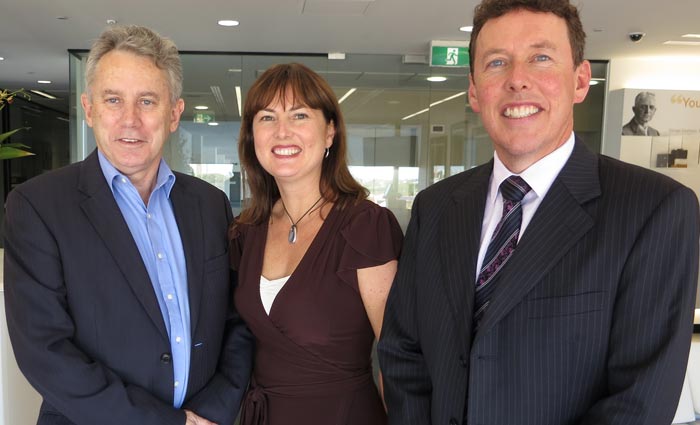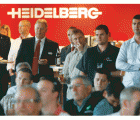
How will PacPrint13 be different from 2009 for visitors?
Karen Goldsmith 2009 was coming off the back off the GFC, which had just hit, so there was a bit of a shell-shocked atmosphere. I think there’s a lot more positivity around now about how to move forward. Through the forums, you’ll see an industry in transition. I think our focus has been on how to help exhibitors and visitors look forward to what the industry is going to be in the next five years. We’ve spent a lot of time on recruiting the right exhibitors and attracting the right visitors.
There has definitely been a lot of change since 2009 and it’s going to continue to keep changing as we transition through. I think that’s the key.
Bill Healey For me it would appear the focus has shifted; it’s much more holistic and not just about production. It’s looking at the whole supply chain. It’s focusing on digital e-commerce, web-to-print stuff. There’s a recognition that digital print is a key component of the industry from now on. The co-location with Visual Impact Image Expo is also a reflection of the broader industry.
How will visitor numbers compare with 2009?
Goldsmith From 2005 to 2009 to 2013, PacPrint has been a very strong reflection of the current industry. It has experienced the same contractions that the industry has.
Healey The industry has reduced to around 4,000 businesses, but to counteract that, the people we are endeavouring to attract here has broadened, too. We are talking to designers and direct marketers.
Goldsmith And procurement specialists.
Healey We’ve talked about how we engage with the electronic mailbox guys because the successful business of the future will have to make decisions across all of those platforms.
It sounds like you’re keen to engage with printers’ customers. Tell us more about the strategy there. End users are an important part of the industry but they don’t buy equipment or software.
Goldsmith We’re trying to get them involved in a more educational focus: trying to sell the benefits of print. We are getting those people to come to workshops specifically highlighting the benefits of the printing process and the use of paper, and paper as part of the wider mix.
Ian Martin We are trying to encourage our customers to bring their customers along in order to see the value of print as a medium.
Is there an element of trying to tie PacPrint into campaigns like Two Sides that aim to defend print and promote its place?
Goldsmith I think it always has. If you look at PrintEx11, we had the Power of Print promotion.
Healey This is one element of that broadening of the community awareness of the environmental and economic value of print paper. The audience is more open to this now. I mean, when I walked around PrintEx there was still a clear distinction between offset and digital, whereas now most people have got access to both.
Martin They are less interested in which technology is used to produce it. If you look at 2005 through to 2013, there has been a massive influx of digital, which is reflected in the exhibitors.
Healey When we did our research of potential visitors, digital was overwhelmingly the area they have an interest in. Web-to-print was another area.
Do you think people will miss the big offset presses?
Martin I don’t think there’s an expectation there to go along and see the traditional offset heavy metal anymore. People used to have web presses at exhibitions and then now that’s gone by the by. No one expects that now. I think people aren’t focused so much on the technology. As we said earlier, it’s more about what’s the right tool to achieve the end result –whether it’s digital or offset. I think that’s the focus now.
That said, don’t big, fast machines still get people through the door?
Martin The printers’ medium is tactile so you can guarantee that people will still want to see samples and pick things up. You put the posters out and everyone flocks to them and grabs them. That is the benefit of print as a medium in terms of its ability to get a message across to a wide audience.
Goldsmith In 2009, our biggest growth was wide-format. That was really exciting. That has caught up a little bit now too; it’s becoming more mainstream for the commercial printers to move into wide-format.
Martin There are other markets associated with that, like the outdoor display or packaging. Even car wraps.
What about international visitors?
Goldsmith PacPrint is a very regional show. A very Australian show. We have a large contingent coming from New Zealand and we have some Samoans, some New Caledonians, some of the Pacific Regions, but we really don’t get a lot [of overseas visitors].
In regards to what is happening with Ipex, with so many exhibitors withdrawing, how has this affected your planning?
Healey It’s horses for courses. Maybe the reason we’re doing OK and Ipex is not is because PacPrint is the right size for the right market. But you must have had some interesting conversations with vendors. They must be really trying to get bang for their buck, especially after Heidelberg pulled out.
Martin We don’t really talk about individual exhibitors. But other exhibitors could view it as a positive, because one of their competitors is not going to be there. I’d say that’s how the majority of vendors viewed that: they viewed it as a decision that one of their competitors was not going to be there. Quite maturely, they saw that the decision was out of local people’s control. That could happen to any international company. With regards to what exhibitors are asking us, they want to make sure we get the right people there and that’s something that we’ve been speaking about – how to get the VIPs.
Goldsmith They want decision makers.
Martin If you look at and compare 2005, 2009 and 2013, you’ll see more decision makers here in 2013. Everyone says that even if you’ve only got a few people there, if they’re decision makers, it doesn’t matter. That’s where we’ve really seen a major change. That is why we’re focusing on making sure we get VIPs.
So you are trying to attract the big spenders who are ultimately responsible for signing the cheque?
Martin Exactly. The key thing is to get those people along. Of course, you want other people within the business as well. You want people in the production side. It is always a challenge though these days, with the amount of time they can get off work and so forth for travel.
By trying to bring in print buyers, do you also see that as a potential attraction for printers to come along?
Goldsmith Yes, definitely.
Martin For five days in May, PacPrint is going to be the focus of the printing industry.
Is it also the responsibility of the exhibitors to get visitors to come to the show?
Goldsmith It has to be. It’s a major investment for them so they have to treat it as a major marketing spend. I think that they always do take it seriously. They all have their own databases of customers and if the message is coming from PIAA, coming from GAMAA, coming from PacPrint board, coming from the exhibitors, coming from the trade media – it will be strong. We always have fantastic support from the trade media.
It is about getting that message out and we especially rely on them. We’ve got databases for the customers’ customers, but the exhibitors are the best people to talk to in terms of getting customers to come along and invite their customers.
Healey The show is seen as a part of a much broader initiative. This is a focal point for your engagement with your customers.
Can you give us some reasons why visitors come to the show?
Healey I can give you one: can you afford not to come? Given the current state of the industry and the transformation of the industry, can you really afford not to at least spend some time out of your business to look at what’s happening in the industry and map some strategies or identify some strategies to take you forward? Because change isn’t going to go away.
The tensions in the industry at the moment are structural. It’s not cyclical. We’re endeavouring where we can to use this show to highlight some of those key trends, both in terms of technology, but also in terms of information.
What if a printer knows he has no budget to invest in equipment in the next two years – why should he still attend?
Goldsmith You just have to be there. You have to know what’s happening in the industry, it’s not only technology that changes. The networking is really positive – get out there and talk to other people. You are meeting fellow printers and talking about what they’re doing to get through this. The show puts up a valuable forum for this.
Healey You don’t need to buy a machine, you need to know your customer better. You have to shift from a production focus to a solutions provider focus. The solution might not be a better machine, it might be how you identify and engage with your customers.
Goldsmith It might be talking to government departments around what support there is in the industry for your type of business or investment planning.
Will there be some of that at the exhibition?
Goldsmith There’s all that type of stuff.
Martin There are forums and also workshops. I think one thing the industry is very good at is working in the business, but not necessarily working on the business. That is really what PacPrint provides: an opportunity. Talk to your competitors, talk to different suppliers.
It gives you a chance to step away from working in your business all the time to saying, ‘right, where do I want to go? Where do I want to be in three years’ time, five years’ time?” Because there are solutions for that and they don’t have to be expensive solutions either.
Goldsmith I think sometimes the attendance at a show can simply be a way of getting some more enthusiasm back into the industry. I always come away from the show a lot more refreshed – well, not physically refreshed – but excited about the possibilities.
I think we need that. We all need to come together and talk about how we can do things better.
Healey And the National Print Awards. If you need any evidence of the quality and the unique contribution that the industry makes to communication in our society, you can’t get better than that. It is a showcase of excellence.
I’m reluctant to say that PacPrint is more than a trade show, because it is a trade show and it is about equipment and supplies and that is what people invest in. But what we’ve endeavoured to do is to balance the information and advice and motivational aspects of it through the forums and workshops.
There is always a problem at a trade show if you have too many forums involved – you could drag people away from the trade show. I think we balance the two as well as we can.
Goldsmith That comes back to the question of what the exhibitors are asking for. They’re asking for support, not just in generating the audience, but also in the events around that: we include breakfast, we have the NPAs, and we’ve got several supplier functions.
Healey The smart people are open to suggestions and they want to be exposed to new ideas and new ways of looking at things.
What will success at PacPrint 2013 look like? How are you going to measure that?
Goldsmith We focus on categories of visitors. We’ve got targets across decision makers, leaders within the industry and also the categories that we’re looking into.
Martin Yes, it’s the categories of visitors, from decision makers down to production people, sales people and so on. Then there are the different sectors within the market, and ensuring we have those and have achieved penetration into those sectors as well.
Goldsmith We also do a lot of surveying of our exhibitors and visitors to get results, so will be analysing that to see that people are happy.
Healey We’re fortunate that a lot of the nuts and bolts are handled really professionally by [exhibition organiser] Reed. They’re the ones who make it happen and that is a plus.
Goldsmith I think that is where a lot of the happiness of the exhibitors comes from, just that professional show organisation. They feel that they’re making a significant investment in the show and it is treated seriously by the Reed management.
Comment below to have your say on this story.
If you have a news story or tip-off, get in touch at editorial@sprinter.com.au.
Sign up to the Sprinter newsletter


